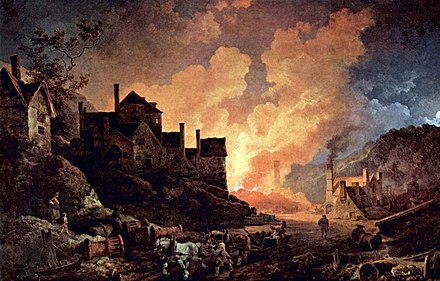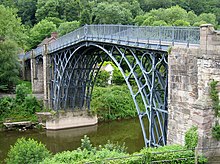Industrial Revolution
The Industrial Revolution is the term used to describe the profound and lasting transformation of economic and social conditions, working conditions and living circumstances that began in the second half of the 18th century and intensified in the 19th century, initially in England, then throughout Western Europe and the USA, and since the late 19th century also in Japan and other parts of Europe and Asia, leading to the transition from an agrarian to an industrial society. The most important social classes involved in this upheaval were capitalist entrepreneurs and wage-dependent proletarians.
The Industrial Revolution led to a greatly accelerated development of technology, productivity and science, which, accompanied by a sharp increase in population, was accompanied by a new kind of intensification of social grievances: there was a partial shift of pauperism from the countryside to the cities, without adequate housing; and a wage-earning proletariat was concentrated in the emerging factories for which labour was needed. This gave rise to the social question as a core socio-political problem, combined with recurrent workers' unrest and efforts by social reformers to alleviate acute hardship and address its causes.
From a world-historical perspective, the Industrial Revolution is ascribed a similar significance as the transition from nomadism to sedentarism in the Neolithic Revolution. With regard to the Industrial Revolution, two conceptual levels emerged over time: one refers to the epochal designation associated with the emergence of large-scale industry, the other aims at an unfinished process of ongoing social change. The proletarian classes, which had been most disadvantaged in pre- and early industrial times, also gained in quality of life as the Industrial Revolution progressed, with great domestic social inequality increasingly being understood as a problem. Broader strata of the population came to relative prosperity through work in industry after organized and more or less successful labor struggles.
Some economic historians and social scientists characterized later historical upheavals in economic, production, and labor forms as the second and third industrial revolutions (Also, technical advances in the Middle Ages, such as the use of water mills to drive hammers, saws, pumps, and bellows, are referred to as "industrial revolutions"). French sociologist Georges Friedmann first spoke of a second industrial revolution in 1936. He dated it to the decades around 1900 and identified as its characteristics intensified mechanization, the widespread use of electricity, and the mass production of goods (Taylorism and Fordism). The microelectronic revolution since the mid-1970s is seen as the technological core of a new, third industrial revolution, for example by the US sociologist Daniel Bell. The debate on Industry 4.0 has given rise to the term "fourth industrial revolution" (for example at the World Economic Forum 2015 in Davos). However, the technological basis of the described computerization of manufacturing technology and closer networking between production and logistics is still microelectronics. The industrial researcher Hartmut Hirsch-Kreinsen speaks of a "second phase of digitalization".
In 2000, the chemists and atmospheric scientists Paul Crutzen and Eugene Stoermer proposed that the period since the beginning of the Industrial Revolution should be regarded as a new epoch in the history of the Earth under the name Anthropocene, since human influence on the planet has become increasingly important since then.

Coalbrookdale by Night . Oil painting by Philipp Jakob Loutherbourg the Younger from 1801. Coalbrookdale is considered one of the birthplaces of the Industrial Revolution, as the first coke-fired blast furnace was operated here.
Term History
The term Industrial Revolution originally came into use as an analogy to the French Revolution. The changes in the forms of industrial production, especially in Great Britain, appeared to be of similar epochal significance to the political changes in France. The term was used in this sense, for example, in a report in the newspaper Le Moniteur Universel in 1827, and likewise by Adolphe Jérôme Blanqui in 1837. However, Blanqui's short formula, "No sooner had the brain of the two men of genius Watt and Arkwright sprouted than the Industrial Revolution took possession of England", is considered incompatible with the current state of economic history research: "The view of the Industrial Revolution as a heroic story of great inventors is in urgent need of revision", wrote Pierenkemper in 1996.
The term industrial revolution was first used as a process and epochal term in 1839 by the Belgian economist and publicist Natalis Briavoinne in his two-volume work De l'Industrie en Belgique ("On Industry in Belgium"). Outside the Francophone-speaking world, the first mentions are found in 1843 in Wilhelm Schulz's The Movement of Production and in 1845 in Friedrich Engels's The Condition of the Working Class in England. Engels also compared the political revolution in France with industrial development in Britain. For him, the industrial revolution was an epochal turning point: "The industrial revolution has the same significance for England as the political revolution had for France and the philosophical revolution for Germany".
While the term was limited here to the industrial development originating in England, Schulz had already applied it to earlier epochs. In this, he was followed above all by the Anglo-Saxon tradition, e.g. John Stuart Mill, who used the term in 1848 to describe any rapid technological and social change. Arnold Toynbee (1852-1883) made the term generally widespread, and was therefore long credited with coining the term. In the 20th century, the understanding of the term in the sense of "age of industrialization" became more prominent.
Historians commonly use the term industrial revolution to refer to what happened on the British mainland between about 1750 and 1850, while otherwise the term industrialization is used when an economy has a steady per capita growth in real output of more than 1.5 percent over several decades.
Conditions of origin in Great Britain
→ Main article: Causes of the Industrial Revolution
It has proved rather doubtful to try to determine specific individual causes of the Industrial Revolution. Quite a few of these also existed elsewhere, for example in the Netherlands, in northern France or in central Japan, so that the reverse question has also been asked as to why such an upheaval did not occur in one of these regions.
For the United Kingdom, a set of conditions can be identified within which individual factors were specifically significant. These include:
- a preceding period of peace that lasted many decades;
- a single economic territory without customs barriers in an insular situation;
- large-scale, relatively productive agriculture with a surplus of labour;
- a geography favourable to traffic and transport and rich, easily exploitable coal deposits;
- the colonial possessions and extensive colonial trade (partly as barter trade) that provided for the import of raw materials and sales markets;
- the developed precision mechanics and toolmaking;
- a partially widespread entrepreneurial mentality, especially in some religious milieus.
Of particular importance for the continuous industrial upswing was, on the one hand, the domestic demand for upmarket goods, which was based on relatively broad circles, and, on the other hand, the already advanced overseas trade, especially with North America, as well as the formation of a technical culture based on a stream of innovation flanked by British patent law. Although there were also a large number of energetic inventors in France, they mainly presented their innovations to other scholars, while the English innovations often flowed directly into industrial production.
Even on the eve of the Industrial Revolution, the standard of living in Western Europe was widespread and well above subsistence level, and was considerable in comparison with other regions of the world. This relative wealth was particularly pronounced in Britain, "a product of 'primitive' accumulation that had already lasted at least two hundred years." According to Buchheim, the pre-industrial productivity advances of the British economy in the eighteenth century were for the first time so great that, despite a growing population, there remained a surplus of "free" resources that could be used to initiate a new kind of sustained growth process. This opened up a way out of the Malthusian poverty trap in the long run. The mild climate in England favoured the process; there were fewer famines (often caused by cold waves, heat waves and other climatic extremes) than in other parts of Europe.

Cast iron bridge in Shropshire
Questions and Answers
Q: What is the Industrial Revolution?
A: The Industrial Revolution refers to a significant change in the way things were produced, with the use of machines in factories to replace small-scale, hand-made production.
Q: When did the Industrial Revolution start?
A: The Industrial Revolution began in the 1760s.
Q: How did the Industrial Revolution affect the way products were made?
A: The Industrial Revolution changed the way products were made by replacing small-scale, hand-made production with machines in factories, which made producing products in large quantities more efficient and cheaper.
Q: What did the Industrial Revolution mean for the cost of products?
A: The Industrial Revolution meant that products were sold for less since they were made in larger quantities, which helped to make them more affordable for people.
Q: How did the Industrial Revolution impact people's lives?
A: The Industrial Revolution had a significant impact on people's lives as it resulted in many people moving from an agriculture-based life in rural areas to towns, where factories offered better-paid work.
Q: When did the Second Industrial Revolution start?
A: The Second Industrial Revolution began in the 1870s.
Q: How did the Second Industrial Revolution differ from the first?
A: The Second Industrial Revolution saw a focus on more advanced technologies, such as electricity and the internal combustion engine, which allowed for even greater production efficiency and economic growth.
Search within the encyclopedia